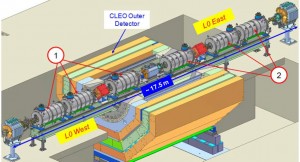
Layout of the reconfigured and instrumented CESR interaction region with ILC-like damping ring wigglers.
The next generation of particle accelerators will contain intense bunches of particle beams. These intense beams have the disadvantage that they create electron clouds that result from beam scattering off residual molecules in the vacuum chambers. The concern is that the presence of electron clouds can reduce performance by scattering and defocusing the incoming particle beams. Quantitative information on electron cloud effects has been rather limited. Therefore, a key goal of the ILC R&D programme has been to carry out experimental studies of electron cloud effects in an ILC-like low-emittance ring and test various mitigation schemes that could be employed in the ILC positron damping ring.
The CesrTA programme began by reconfiguring the Cornell Electron-Positron Storage Ring (CESR) into a low emittance ILC-like ring and instrumenting it to perform electron cloud studies. The resulting R&D programme has been highly successful in providing detailed data that has led more generally to a better understanding of electron cloud effects. In addition, various proposed mitigation schemes have been tested and reliable mitigation strategies have been developed for the ILC positron damping rings. The CesrTA collaboration has recently released a detailed report (60 MB) that will be very valuable to the next generation of particle accelerators, not just for the ILC.

Mitigation techniques include using grooved chamber surfaces (left) in the dipoles and clearing electrodes (right) in the high-field wigglers.
The function of the ILC damping rings is to capture electron and positron beams that have large transverse and longitudinal emittance and “damp” them into low-emittance beams required to achieve the high luminosities. A configuration at CesrTA similar to ILC damping rings was replicated to be able to reliably predict performance of the ILC damping rings. For example, analytical estimates of what is called the head-tail instability thresholds, an effect due to having particles with different momenta in a beam, have been made for both CesrTA and the ILC damping rings. The observed instability thresholds for CesrTA’s low-emittance conditions agree well with these calculations using the measured electron cloud density. The good agreement between data and experiment for CesrTA provides confidence in extrapolated estimates for the ILC damping rings.
The CesrTA collaboration tested various mitigation techniques in order to develop a mitigation strategy for the ILC positron damping rings. Three different techniques have been studied: grooved chambers, titanium nitride coatings and clearing electrodes. Although coatings show promise, long-term performance and durability studies will need to be carried out in the future Phase II CesrTA programme. A working group was formed to develop a mitigation strategy. Their primary recommendations are for titanium nitride (TiN) coating in the drift regions, triangular grooves with TiN coating in dipole regions, TiN coatings for quadrupole regions, and clearing electrodes in the crucial wiggler regions.
The working group mitigation plan is very aggressive because it anticipates a possible future doubling of the number of positron bunches in a single damping ring. The group also notes that their recommendations have a large overlap with the design for the SuperKEKB vacuum chambers, so that machine will provide valuable information on electron cloud mitigation for the ILC positron damping ring.
CesrTA has been one of our proudest achievements from the ILC R&D programme. It has established the reality of coping with a potential major issue that must be confronted for a high luminosity linear collider. CesrTA was a major achievement in collaboration of different laboratories and funding agencies in contributing equipment and personnel for an accelerator R&D project. It will have considerable and broad value for the next generation of particle accelerators.



Recent Comments